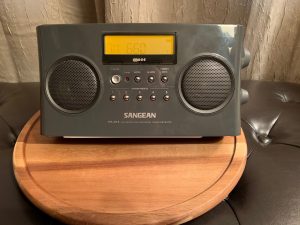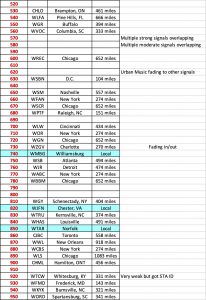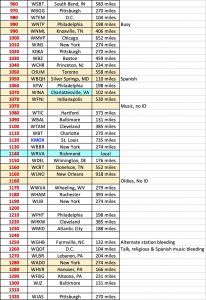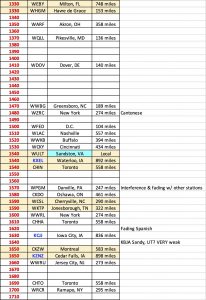Guest Post by Troy Riedel
Since the demise of my Sony ICF-SW100, I’ve decided to do some AM Dx’ing. A few years ago I purchased a Sangean PR-D15 as my dedicated “AM Dx Radio”. Despite owning it for a few years, I hadn’t yet really put it through its paces.
Note: My 1994 Gründig Yacht Boy 400, with its 150mm (5.9″) ferrite rod antenna, performs splendidly on AM and until this purchase, the YB400 was the radio I grabbed for AM Dx.
At the time of my purchase – if my memory is correct – the other models I had considered were the CC Radio 2 (now discontinued), the CC Radio 2E (it was a relatively new release at the time), and the Original CC Radio EP (now discontinued & replaced by the CC Radio EP Pro).
Admittedly, part of my decision was based on cost. At the time, the CC Radio 2 & 2E were priced over 2x the cost of the PR-D15 and the CC Radio EP was $15-$20 more when shipping was added. Besides the cost, I chose the PR-D15 based on a few things I had read online. But the aspect that really appealed to me is the 200mm (7.9”) Ferrite Rod Antenna and that compared favorably with the C. Crane offerings (yes – ferrite size isn’t everything, but it is an important consideration). So after having read online comments (reviews, discussion boards, etc.) about the PR-D15, I felt very comfortable with my decision and it wasn’t based on cost alone.
Frankly, I don’t really care how well my AM radio performs during the day (I hope this isn’t sacrilege). Why? During the day whether I’m in the car, working in the garage – whatever – I’ll typically stream my favorite station (NYC) via radio.com on my iPhone so I can pause, rewind, or pick-up where I left off. Until my Sangean PR-D15 can do that, I prefer to daytime stream. My “hobby” of AM Dxing is in the evening – to relax and have fun (and isn’t that what a hobby is supposed to be?). Keep that in mind as I reveal my results.
I intended to do my AM Dx Nighttime Test in one night, but I was getting so may stations that I had to extend it over two nights. I started each session around 8PM and they lasted until 11:30PM – 12AM (over 7.5-hours of testing on consecutive nights late this week). I had my PR-D15 on a lazy susan turntable and I had two nearby laptops – one to aid as an AM Station locator and the other I used to stream. Stream? Yes – to count as a recorded station I had to get a positive station ID. However, many radio programs are syndicated. Syndicated radio (and ESPN radio) can go on seemingly forever between station IDs. If I didn’t get a station ID within 15-minutes, I used the second laptop to go to the web site of the station I believed it to be to “listen live” to see if the radio and the stream matched-up (luckily live web streams are slightly behind live terrestrial radio so the IDs were easy). Often by the time I had given-up and gone to my 2nd laptop, I’d finally get an on-air station ID. I just didn’t want to waste too much time on one station and miss other stations.
Since my test extended for 2 nights, on night two I quickly dialed-through nearly all of the stations I confirmed on night one to make a quick re-confirmation they were still audible on the 2nd night.
Since I captured so many stations, I was overwhelmed trying to finish and thus I feel this test is still incomplete. My wife typically ends all of my radio playtime (my man cave is a “sitting room” off the side of the master bedroom & there is no wall – no door – so it’s completely open). But my wife and my step-daughter have a weekend out of town in mid to late March. And that means I can stay up all night and do one non-stop test session. Is it bad to say that I cannot wait to be alone?
My QTH is ~ 35-miles east of RIC (Richmond, VA) Airport. The tables below (broken into three files) are my results. Some frequencies have multiple station IDs – since when turning the radio and nulling signals, sometimes one station disappeared and another jumped onto the dial. If/when I post an update of my all-nighter, I’ll add another column to the spreadsheet to include the transmitter strength for better context. It should also be noted that I recorded straight-line distances & not driving distances (via an online straight-line/GPS calculator).
I was impressed that I successfully captured three Iowa stations. And though I find it almost unfathomable, I truly believe I was on the verge of successfully logging a station in Sandy, UT which is over 2000-miles away (there are only six stations assigned to the 1640 frequency, and given the content I [barely] heard, all indications are that it was KBJA)!
I also believe I captured at least one Super-Clear Channel station from Mexico, but unfortunately I just couldn’t successfully verify the station ID. I hope to have a future opportunity to add it to my list.
My ultimate goal is to: (1) compile & maintain a spreadsheet of every AM station that I am able to successfully ID; and (2) maintain a record of the most AM stations I was able to ID in a single one-night, non-stop session.
Despite being somewhat incomplete, I’m impressed by my results. I’m interested to see what you think so please post your comments below!
I should note that my results are strictly off the internal ferrite antenna – no external antenna, no passive loop antenna was used to enhance any signal.
To save column space, please click on each table below. A larger & easier to read image will open in a separate window or tab (depending upon your browser setting).





Troy,
Read your article through, twice as it communicated the fun you are having sitting down, tuning the dial and challenging yourself. I started a similar project using a composition book, dedicating 1 paage to each of the MW channels. Then I started at 530 and worked my way up through the band noting who I heard making note if it was a daytime logging or night.
I noticed you logged WTAR. I have been the engineer for that station and WNIS (+3 FM’s) for a number of years. The transmitter for WTAR is is Rushmere, VA off Rt 10, just southwest of the Surry Nuclear Plant, If you might be interested in taking a tour of a 50KW transmitter plant, would be glad to do it. It would be a straight shot down RT 460 to Windsor then east or, straight down Rt 10. I’m fairly close, down in Chesapeake.
Finally, here is a tool you might find useful, its an online AM pattern map listing each MW channel and shows both the daytime and night transmission patterns. Notice our 50KW on 850 is directed toward South AFrica at night. We get 3-4 reception reports from southern Africa a year.
https://www.nf8m.com/nf8m/us-medium-wave-pattern-references/
Keep at it!
Chuck Rippel
Chuck,
Sorry for the slow reply. I am very familiar with that area, that route. I often ride through that area on my H-D (I had a GF back in the day who lived in Windsor – it’s a nice ferry trip on the Harley from Jamestown to Scotland). I’d love to take a tour. I made this email address for the shortwave broadcast a did several years ago: astronomyQSL [at] Gmail [dot] com. I’d love to connect.
Cheers,
Troy
Come Join IRCA (https://www.ircaonline.org/default.php ) – we don’t bite. Hard, anyway.
$5 and you get 30-some issues of the newsletter every year (more in the MW DX season, fewer in the summer). Note that the newsletter is not mimeographed and is in PDF format and pretty well done, IMHO (I am not involved in its production!).
Your log is *impressive*.
AM radio isn’t dead yet, though, clearly, it’s not particularly healthy, and sure, a lot of the programming is mush, but it’s still fun to hear 250 W stations from 1000 km away!
Hey Peter,
Thanks mate! I appreciate the motivating comment – I’ll check-out that link this weekend!
Cheers,
Troy
Troy – Nice write up – thanks for putting it together. Right now I’m listening to Big Band Roundup on AM 740 on a Tecsun H-501. Not really DX as they are directly across the lake from me.
Been into MW DX’ing since the 1970’s. Listening ebbs and flows, moved to this location 6 years ago and log all stations received. Totals to date @235 stations logged on a Eton E1 with a variety of external antenna – always tinkering. My most distant logs are KOA 850 Denver and CBW 990 Winnipeg.
Cheers,
Gregory
Gregory,
Thanks for the comment. Maybe someday I’ll approach that number. Is that 235 number all from your current location?
Thanks again for the comment,
Troy
…ANY cheap radio can pick up AM at nite-time, but it takes an exceptional AM radio for daytime DX’ing without an external antenna! The CCrane 3 Bluetooth (General Electric, RCA, am long distance radios were manufactured during the 1970’s!). How does it perform during the daytime…? How does the Sangean 909×2 pan out?
Mike,
I don’t normally have an opportunity for AM Dx’ing – but I’ll find time to put my Sangean PR-D15 through the paces. And yes, “ANY cheap [AM] radio” can perform DX [to a point] – but surely not at the level of the results of the PR-D15.
Thanks for commenting mate,
Troy
WFLA 540 is really WFLF — they do IDs as “WFLA Orlando” but that’s their FM affiliate.
https://radio-locator.com/info/WFLF-AM
https://en.wikipedia.org/wiki/WFLF_(AM)
David,
Awesome, thanks for that info!
Much appreciated,
Troy
There are few things constant in life. One of them seems to be AM DXing. I started in 1958 with a GE P755A, one of the first transistor portables (my dad’s). Since then, I have restored several of them and they continue to amaze me. I still have a 1958 dog-eared copy of Vane A. Jones’ North American Guide.
Not long after that FM radio became the dominant band and mode of transmission, and I felt the days of AM radio were numbered. Well, here we are 63 years later and there are more AM stations than ever. I can’t think of any non-hobbyist who listens to AM radio. I just don’t understand the economics of it. But I’m certainly not complaining.
Bob C.
Great comment Bob! I became interested in AM Dxing in the 70’s (as a kid) – but I’m relatively new to re-igniting that portion of my radio hobby. I’ve done OCNL AM bandscanning over the years, but i never really logged what I accomplished until very recently.
One of the best sources for MW info since the 1930s has been the National Radio Club. Google it, and check out the Club page, as well as the Facebook page and large collection of past paper bulletins on yet another link.
In my “clubin’ days” I was privileged to know several of the old timers, a few of whom were around in the early days of radio. Their QSL card collections were amazing.
In the ’60s and ’70s, Region 2 (the Americas) was not completely locked down with every station conforming to the 10 kHz separation. There were some exotic, low-power, “split channel” catches to be found such as Belize on 834 kHz. Even now an occasional trans-Atlantic power house can poke through when things are right.
I like Big Band Sunday Night on 740 kC, but it can only be heard on radios build before 1960. Hi!
Bob C.
Bob,
I Googled as suggested – great tip, it looks very interesting – thanks!
Troy
RadioJayAllen gave a glowing review to it “it’s AM reception is very close to the C. Crane CC-2E”.
https://radiojayallen.com/sangean-pr-d15-amfm-stereo-radio/
Zack N8FNR
Zack,
Yes indeed, that was one of the reviews I read a few years back prior to purchasing my Sangean.
I find that a lot of reviews focus on daytime listening & video comparisons. That’s all well & fine – and reviews should focus on that – but a lot of reviews neglect nighttime scans & comparisons. And that’s what I do. Radio is like anything else: you have to match-up somethings capability versus what you’ll be using it for. I’m a truck-guy, I pull over 17,000 lbs. I’m more interested in a truck’s towing capability than it’s fuel mileage (or other amenities) so that’s what I need from the manufacturer, in reviews & in online comments. As I stated in the post, my only real concern with an AM radio is how it performs at night and nighttime bandscaning reviews/comments & manufacturer specs (ferrite size) is what lead me to the PR-D15.
I’m quite happy. For the price, IMO you can’t beat the PR-D15.
Cheers,
Hi Troy, now that’s a full, gapless AM band channel list! 🙂 I too still find MW interesting after all those years, not only because it’s a nice mix of same old, same old and little surprises in between but also because (well, in my neck of the wood) there’s still a lot of variety in programming. If that all gets boring, there are still DX challenges to master!
BTW, the technical reasoning behind trying and comparing AM radio during daytime is this: If you want to assess (or demonstrate) raw sensitivity and put that into relation with former or future tests at the same time/same spot you want to rule out signal variations of skywave propagation. Daytime groundwave signals are pretty stable within some margin and QRN is much less prone to thwart the SNR.
If you will, it’s the basic measurement of how much payload your truck will pull. Once you know that, nighttime DX is the proof in the pudding, the road driving test, even with similar variables like varying weather (condx), road conditions (QRN) and traffic (QRM). 🙂
The latter is also the reason why it never really gets boring, a different time at night, a different season and the constant variations in skywave conditiions may let us hear different distant stations between the big guns each other time we try and there’s always a chance to achieve even more “mileage” and enjoy how powerful radios can be. And of course AM radio has that special sound to it, which I love!
Wow, as most know I’m not a ham … I’m not a “radiohead” (I use that term endearingly, with the utmost of respect). That explanation makes total sense and I thank you for that.
Yes, the beauty of AM Dx – night-to-night (sometimes minute-to-minute), the season, the weather & atmospheric changes cause some doors to close while others open.
That “full” band I encountered makes it obvious why I could not complete this informal test in one night. I know there was more out there to verify & log especially in the lower bands. I just didn’t feel I had adequate time to coax out and verify a few of those signals. And I think I could have nulled & extracted another station or two on several frequencies (it was so crowded, once I had an entry for a frequency I tended to move the dial to the next). I hope to get that all-nighter in during March to correct some of these short-comings.
Eventually I’ll experiment with passive loops (and a technique posted online by “Kevin S.” of simultaneously using two passive loops to “notch” and to remove spurs – if I encounter any). And I do own a C. Crane Twin Coil Ferrite antenna so I have options to vary my Dxing.
I envy those AM Dx’ers who live in the heartland and thus have the potential to AM Dx coast-to-coast. I’m thinking about driving far enough away from my home to escape my local Norfolk, VA AM 850 b/c I think the clear channel KOA Denver just might … *might* … be within reach. But without any enhancement, that’s probably my westward limit. Note: I did have an usually distant FM Dx “catch” several years ago in my truck that is chronicled here:
https://swling.com/blog/2016/07/fm-dxing-troys-unexpected-catch/
As always, I appreciate your insightful, thoughtful comments.
Cheers,
Troy
Hi Troy,
Sounds like you had a lot of fun doing single sessions AM BCB DXing. Also looks like you are now hooked on it. I’m located more north of you (5 miles north of Atlantic City, NJ) but was interested in comparing your list of stations received to mine and was delighted to see many of the same.
The New Jersey Antique Radio Club (NJARC) does a members only AM BCDX contest each January. It’s very similar to what you did – see how many stations you can receive in a 24 hour period, and then submit the top ten that were the farthest away, The total of the ten stations mileage is the score. Since NJARC is an Antique Radio Club, they encourage the use of antique radios, but do include a couple of categories for newer radios. Last year, I did two radios – the Panasonic RF-2200 and a home made Diode radio. See following SWLing post for my results:
https://swling.com/blog/tag/k3fdy/
This year I used a 1958 Philco Trans-World radio for the contest.
I have to admit that I read with horror that you had two laptops running. These are noise generators and you may find you will have a lower noise floor if you do not have any computers around. The laptops are especially noisy when plugged into the AC since the charging switching circuit kicks in and start generating noise. If I do need to use a laptop, I make sure I run it on battery power only. When I do the NJARC contest, I unplug all my computers, UPS’s and other wall warts just to reduce the level of noise in the house.
I have a couple of challenges for you:
On 530, if you null out CHLO as much as possible, you might be able to hear a Cuban station. This would be Radio Enciclopedia. It broadcasts light music.
On 870, if you null out WWL, you should be able to hear the Cuban “Time” station. This is Radio Reloj. You should be able to hear the Ticking sound and the “RR” in code ID at the top of each minute. The station broadcasts news for 55 seconds of each minute. You can find them on many frequencies.
Radio Reloj Cuban Time Station Frequencies: 570, 610, 760, 790, 830, 930, 940, 950, 1010, 1270 KHz
Tick on the second, beep on the minute, then RR in Morse “DIT-DAH-DIT DIT-DAH-DIT”
Good luck with your BCB DXing. It’s a lot of fun.
73
Bill
WD9EQD
Smithville, NJ
Bill,
Wow, great tips mate – I really appreciate that. I became interested in AM back in the mid-late 70s as a kid. I didn’t know it was called “AM Dx”, but many nights I’d be awake and have a sub-standard AM radio in bed with me trying to pull-in New York, Chicago & St. Louis.
I think this is funny – when I shared the spreadsheet with my adult son (born in the 80s) he told me, “you and mom probably didn’t know it, but when I was supposed to be asleep I used to go the bed with an AM radio to listen to Michael Jordan’s Chicago bull games” (from VA). That actually made me feel good (maybe because he was a great school student and graduated college?)!
Re: the laptops
Yes, I hear you – but to my credit, both were running on battery and not AC – and I did test how close I could have the radios to my Sangean. I’m pretty confident I was prudent in my efforts to not introduce any RFI.
I cannot wait to try your suggestions … they may not wait until I have my all-nighter in about 3-weeks! Thanks again.
Bill,
BTW, I forgot to add this comment – I’m delighted you compared my list to yours. Just one person doing this validates me posting this content & the spreadsheet images.
Troy
Bill,
I love your wooden antennas pictured in your Dx contest post!
Troy
One thing I forgot to mention in the post – I did *not* have a single, not one instance of adjacent channel interference.
Troy,
My QTH is in SW Ohio, between Dayton and Cincinnati. I was most impressed with you capturing the three Iowa stations : In Waterloo, Cedar Rapids, and Iowa City. That’s a Wow!
I can’t help but wonder if you just might be able to bag a fourth: WHO in Des Moines, some evening. For some reason, that station often comes in loud and clear at my QTH.
But I must confess, I’m cheating. I’m using a passive loop with my Tecsun PL-880. Have to. That receiver can’t hold a candle to your PR-D15 on AM. Needs all that help it can get on that band, but it’s still fun.
Although, I’ve only logged a fraction of your stations; I’m surprised at how many stations we have in common. Never did get those three IA stations though. But, I’ll give it another shot one of these nights.
Cheers & 73
Hey Roger,
Thanks for the positive comments – they are motivating! I’ve seen YouTube videos of people capturing WHO, but those videos are by DX’ers much closer to Iowa than I am. I’ll put that on my radar and I’ll try for WHO later in March when I attempt an all-nighter.
I also have a PL-880. Though I admittedly haven’t used it much on AM, from reports it seems to do pretty well considering the ferrite rod antenna is only 75-76mm. That’s a far cry from the PR-D15’s 200mm … those two would not be a fair fight. So no guilt is necessary using passive loop!
Thanks again & Cheers,
Troy